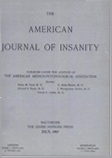X-RAY EVIDENCE OF EMOTIONAL INFLUENCES UPON ESOPHAGEAL FUNCTION
Abstract
1. Esophageal function is definitely altered by emotional factors.
2. Fear, anxiety, apprehension, anger and inadequacy often cause esophageal spasm with narrowing of the esophageal lumen and the production of esophageal symptoms.
3. Joy, achievement, sense of well-being and other positive emotions usually cause the esophageal spasm to disappear and the lumen opens.
4. These changes can be observed directly with the esophagoscope while they are occurring, and indirectly with the fluoroscope and x-ray.
5. Since emotional-functional alteration and organic disease may coexist, a primary diagnosis of psychosomatic dysfunction should not be made until all other causes of malfunction have been eliminated.
Access content
To read the fulltext, please use one of the options below to sign in or purchase access.- Personal login
- Institutional Login
- Sign in via OpenAthens
- Register for access
-
Please login/register if you wish to pair your device and check access availability.
Not a subscriber?
PsychiatryOnline subscription options offer access to the DSM-5 library, books, journals, CME, and patient resources. This all-in-one virtual library provides psychiatrists and mental health professionals with key resources for diagnosis, treatment, research, and professional development.
Need more help? PsychiatryOnline Customer Service may be reached by emailing [email protected] or by calling 800-368-5777 (in the U.S.) or 703-907-7322 (outside the U.S.).



